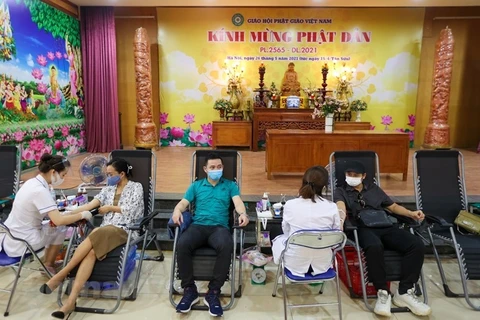Thai Binh (VNA) – Keo Pagoda, which was built in 1632 in the Le dynasty, is one of the oldest in Vietnam where ancient architecture has been preserved.
Located in Vu Thu district, the northern province of Thai Binh, the pagoda initially included 157 compartments covering a total area of 58,000 sq.m.
It is surrounded by three lakes, one in the front and two at both sides, creating a beautiful surrounding.
Also known as Than Quang Tu, Keo Pagoda worships Buddha and Duong Khong Lo, a monk of the Ly dynasty, who founded the pagoda.
Duong Khong Lo was born in 1016 in Giao Thuy district, the northern province of Nam Dinh. He became a monk at 29. In 1061, after practicing Buddhism in India, he returned home and founded Nghiem Quang pagoda. In 1167, King Ly Anh Tong changed the name of the pagoda from Nghiem Quang to Than Quang.
However, it was pulled down by a typhoon in 1611 and rebuilt in 1632.
The pagoda now has 128 apartments covering 2,000 sq.m. Despite several upgrades and repairs over the past 400 years, Keo Pagoda retains its unique architecture from the 17th century.
The section for worshiping Buddha houses nearly 100 statues. At its rear is the area for worshiping the founder of the pagoda. Next to the section for worshiping genies is a well walled with 36 rock barrels which, according to legend, were used for polishing rice for those who built the pagoda.
The bell tower is the most outstanding feature of the Keo pagoda. It is 11.04m high and has a three-layered tile roof. On the first floor of the tower, there is a 1.2 meter-high stone plaque. On the second floor, there is a bronze bell casted in 1686 which measures 1.30m high and 1m in diameter. There are two smaller bells on the third and the upper floors which are 0.62m high and 0.69m diameter, both casted in 1796.
In September 2012, the pagoda was designated as a special national relic. Keo Pagoda Festival was recognised as the national intangible cultural heritage in 2017 and the wooden bell tower of the structure, by the Vietnam Record Organisation (Vietkings) as the tallest of its kind in the country in 2007.
The festival is held annually from the 10th to 15th day of the ninth lunar month to honour the founder of the pagoda.
It features religious rituals and communal activities such as Buddhist offerings, palanquin parades, love duet singing on boats, and a range of folk games like duck catching, rice cooking, and blindfolded drum beating. The traditional folk games and art forms reflect the lifestyle of residents in the Red River Delta in general, and Thai Binh province in particular.
In addition to the autumn festival, a spring one takes place here annually on the 4th day of the first lunar month.
 The Keo Pagoda Festival was recognised as national intangible cultural heritage in 2017. (Photo: VNA)
The Keo Pagoda Festival was recognised as national intangible cultural heritage in 2017. (Photo: VNA) The events feature many traditional and cultural sports and activities closely associated with the life of farmers residing in the Red River Delta, like palanquin processions, swimming or rowing competitions on the river.
Keo Pagoda is not only a place of worshiping but also one to learn more about Buddhism and to explore the history and culture of Vietnam.
The pagoda attracts thousands of visitors to Thai Binh every year./.
























